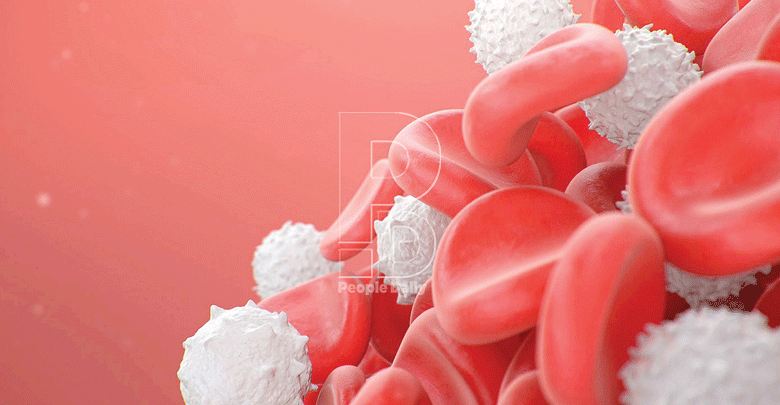Ten types of blood disorders

These are conditions that impact the blood’s ability to function correctly. Otherwise known as hematological conditions, they can involve one or more of the three main types of blood cells; red blood cells, white blood cells, and platelets. They can also involve blood proteins used in clotting. Nailantei Norari explores some of these illnesses.
1. ANAEMIA
Anaemia is the most common blood disorder. It is caused by a deficiency in the number of red blood cells often causing weakness and fatigue in the affected person.
There are several types of anaemia. They include: aplastic anaemia, sickle cell anaemia, and thalassemia.
Aplastic anaemia occurs when the bone marrow fails to produce enough of all three types of blood cells.
Sickle cell anaemia is an inherited blood disorder where blood cells are sickle shaped and block blood flow to the limbs and organs, thereby causing pain, serious infection, and organ damage, while thalassemia is a hereditary blood disorder that affects hemoglobin.
2. LEUKEMIA
Leukemia is a cancer of blood-forming tissues, that hinders the body’s ability to fight infection.
There are many types of leukemia such as acute lymphoblastic leukemia, acute myeloid leukemia and chronic lymphocytic leukemia.
Many patients with slow-growing types of leukemia don’t have symptoms. Rapidly growing types of leukemia may cause symptoms that include fatigue, weight loss, frequent infections and easy bleeding or bruising.
Treatment is highly variable depending on the type of leukemia and the stage it is in.
3. MULTIPLE MYELOMA
Multiple myeloma also called Kahler’s disease is a cancer of plasma cells. The plasma cells are a type of white blood cells in the bone marrow.
With this condition, a group of plasma cells becomes cancerous and multiplies.
The disease can damage the bones, immune system, kidneys and red blood cell count.
Symptoms may not be present or may be non-specific, such as loss of appetite, bone pain and fever.
Treatments include medication, chemotherapy, corticosteroids, radiation or a stem-cell transplant.
4. LYMPHOMA
Lymphoma is a cancer that begins in infection-fighting cells of the immune system, called lymphocytes.
When you have lymphoma, lymphocytes change and grow out of control. The main types of lymphoma are Hodgkin’s lymphoma and non-Hodgkin’s lymphoma.
Symptoms include enlarged lymph nodes, fatigue and weight loss. Treatment may involve chemotherapy, medication, radiation therapy and stem-cell transplants.
5. IMMUNE THROMBOCYTOPENIC PURPURA
Immune Thrombocytopenic Purpura, also known as Idiopathic thrombocytopenic purpura (ITP) is a clinical syndrome where the patient has a decreased number of platelets.
This may occur when the immune system mistakenly attacks platelets. In children, it may follow a viral infection while it may be chronic in adults.
Symptoms may include easy bruising, bleeding and pinpoint-sized reddish-purple spots on the lower legs.
In children, ITP usually resolves without any treatment while adults require treatment.
6. HAEMOPHILIA
Haemophilia is a rare blood disorder in which blood does not clot normally because it lacks sufficient blood-clotting proteins.
When blood cannot clot properly, excessive bleeding occurs after any injury or damage.
Large injuries can lead to excessive bleeding and even death, but small cuts tend to be a non-issue.
Symptoms include many large or deep bruises, joint pain and swelling, unexplained bleeding and blood in urine or stool. Treatment includes injections of a clotting factor or plasma.
7. THROMBOCYTOSIS
Thrombocytosis is a disorder in which your body produces too many platelets which can lead to certain conditions, such as stroke, heart attack or a clot in the blood vessels.
It is called reactive thrombocytosis or secondary thrombocytosis when the cause is an underlying condition, such as an infection.
When thrombocytosis has no apparent underlying condition as a cause, the disorder is called primary or essential thrombocythemia, which is a blood and bone marrow disease.
8. MYELODYSPLASIA
Myelodysplasia is a group of disorders caused when something disrupts the production of blood cells.
Some types have no known cause while others occur in response to cancer treatments or chemical exposure.
Symptoms may include shortness of breath, fatigue, easy bruising and paleness. Myelodysplastic syndrome may progress to leukemia.
Transfusions, bone marrow transplants and medication help manage symptoms and may lessen transfusion needs and slow or prevent progression to leukemia.
9. MYELOFIBROSIS
Myelofibrosis is a chronic disease manifested by fibrous material and eventual scarring of the bone marrow, leading to severe anemia and an enlarged spleen.
It is an uncommon type of bone marrow cancer that disrupts your body’s normal production of blood cells.
Myelofibrosis belongs to a group of diseases called myeloproliferative disorders.
Some people with myelofibrosis have no symptoms and might not need treatment right away, while others with more serious forms of the disease might need aggressive treatments right away.
10. HAEMOCHROMATOSIS
Haemochromatosis is a genetic disorder characterised by iron overload where the body absorbs and stores too much iron.
Our bodies do not have a mechanism to get rid of extra iron. Patients with haemochromatosis have normal iron intake levels, but abnormal regulation of iron absorption.
Iron overload first occurs in the liver where most of the iron is stored. The extra iron builds up in organs and damages them. Without treatment, the disease can cause organs to fail.








